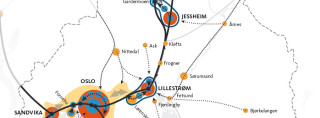Seeing Suburbia

The suburb is a global fact – and it is growing at a surprisingly steady pace. This polynodal form of urbanism must be acknowledged and addressed by planners, policy makers and designers.
There are many definitions of what suburbs are (including associated terms: sprawl, ex-urbia, peri-urban), but there is a general consensus that we are talking about (newer) predominantly residential areas with significantly lower densities than central cities.
Architectural historian Robert Bruegmann argues that suburbs are a direct consequence of prosperity, and as segments of populations across the world become more affluent, suburbs are the result. Historically, increased wealth, such as in England in the 18th century led the emergence of early suburbs, but it is only in the 20th century that technical infrastructure such as trains and cars has enabled the majority of populations in many parts of the world to reside in suburbs rather than dense cities.
The premise of the Future of Suburbia conference organized by Professor of Landscape Architecture and Urban Design Alan Berger and the Center for Advanced Urbanism at MIT was that the continued presence and even increasing dominance of the suburb in terms of total population and the vast land areas and resources involved, warrants renewed attention from the planning and architecture professions. According to Berger, planning professionals and policy makers must overcome prejudice against suburbs, and when it comes to suburb versus city he argues that “no form is superior to the other”. In order to fully understand the phenomena of the suburb and in order to develop theoretical frameworks and new policies, a multidisciplinary approach that includes ecologist, social scientists, planners, etc. is required.
In recent years the ‘Triumph of the City’ has been proclaimed in a wide range of books and talks, referring to the increased popularity of urban, car-free living for a younger generation, which has led to the regeneration of many central urban districts in Europe, North America and elsewhere.[1] In the past decades the suburb has received less attention, a fact Berger and CAU seeks to remedy.
The challenges of the suburb are many (as is the case with the city itself). Debates rage over how unsustainable it is in terms of energy consumption and climate gas emission. In fact, this topic has now replaced many earlier objections to the existence of suburbs (including their dull appearance and lack of public spaces and social arenas).
At the same time, few question the role of suburban landscapes in delivering vital ecosystem services to cities and their inhabitants: supplying drinking water, securing biodiversity, improving air quality and providing recreational spaces for city inhabitants. In addition, suburbs house vital urban functions that no longer ‘fit’ in the traditional city due to their scale or character. These functions prominently include the vast infrastructural systems of modern cities, the industries building the city itself, such as gravel pits and concrete plants, but also large concentrations of workplaces in the form of manufacturing or office complexes.
In his research on Sprawl, Bruegmann traces a history of 20th century remediation of suburbia, which, up to today, largely consists of densifying it, as well as both physically and programmatically transforming what is mostly seen as amorphous urban landscapes into the semblance of denser traditional cities.
Current forms of suburb remediation in the US include strategies for a ‘New Urbanism’ that proposes the introduction of traditional residential and urban typologies in surburbia. However the phenomena seems relatively marginal in the enormous expanse of suburbia in the country. In Europe dominant sprawl containment strategies have moved from introducing greenbelts in order to restrict the outward growth of cities, to nodal point strategies in which the sustainability based compact city model meets territorial infrastructural systems in the form of dense nodal points along railway lines.
In the low density and predominantly suburban Oslo region, this is evident in the recent Area and Transport Plan which proscribes concentrated development around existing public transport nodes.[2] This inter-municipal and trans-regional strategy is an example of how regional planning is often seen as the answer to ‘solve the problem’ of growing suburban sprawl. The development of these urban nodes follows current preferences for an urbanism of density, but the plan is vague when it comes to the future of existing or developing suburban urban landscapes beyond these points.
Despite these measures, the phenomena of sprawling suburbs is remarkably resistant to planner’s attempts at restraining it. As Bruegmann has demonstated: over time and over a wide range of planning regimes in different countries – from laissez-faire to highly restrictive – suburbia continues to expand as populations acquire the means to realize the aspirations that this particular form of urbanization makes possible. Suburbia – despite its seeming visual monotony – reveals the complexity of the city by exposing the conflicts and interactions between planners’ and policy makers’ concern with the common good and the myriad of everyday actions and individual decisions that make up the city.
Illustration: Regional plan for areal og transport i Oslo og Akershus.
[1] ‘The Triumph of the City’ is the title of Edward Glaeser’s book from 2011.



